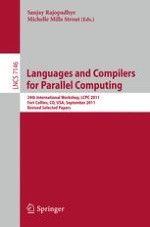2013 | OriginalPaper | Buchkapitel
A Code Merging Optimization Technique for GPU
verfasst von : Ryan Taylor, Xiaoming Li
Erschienen in: Languages and Compilers for Parallel Computing
Verlag: Springer Berlin Heidelberg
Aktivieren Sie unsere intelligente Suche, um passende Fachinhalte oder Patente zu finden.
Wählen Sie Textabschnitte aus um mit Künstlicher Intelligenz passenden Patente zu finden. powered by
Markieren Sie Textabschnitte, um KI-gestützt weitere passende Inhalte zu finden. powered by
A GPU usually delivers the highest performance when it is fully utilized, that is, programs running on it are taking full advantage of all the GPU resources. Two main types of resources on the GPU are the compute engine, i.e., the ALU units, and the data mover, i.e., the memory units. This means that an ideal program will keep both the ALU units and the memory units busy for the duration of the runtime. The vast majority of GPU applications, however, either utilize ALU units but leave memory units idle, which is called ALU bound, or use the memory units but idle ALUs, which is called memory bound, and rarely attempt to take full advantage of both at the same time.
In this paper, we propose a novel code transformation technique at a coarse grain level to increase GPU utilization for both NVIDIA and AMD GPUs. Our technique merges code from heuristically selected GPU kernels to increase performance by improving overall GPU utilization and lowering API overhead. We look at the resource usage of the kernels and make a decision to merge kernels based on several key metrics such as ALU packing percentage, ALU busy percentage, Fetch busy percentages, Write busy percentages and local memory busy percentages. In particular, this technique is applied at source level and does not interfere with or exclude kernel code or memory hierarchy optimizations, which can still be applied to the merged kernel. Notably, the proposed transformation is not an attempt to replace concurrent kernel execution, where different kernels can be context-switched from one to another but never really run on the same core at the same time. Instead, our transformation allows for merged kernels to mix and run the instructions from multiple kernels in a really concurrent way. We provide several examples of inter-process merging describing both the advantages and limitations. Our results show that substantial speedup can be gained by merging kernels across processes compared to running those processes sequentially. For AMD’s Radeon 5870 we obtained an average speedup of 1.28 and a maximum speedup of 1.53 and for NVIDIA’s GTX280 we obtained an average speedup of 1.17 with a maximum speedup of 1.37.
